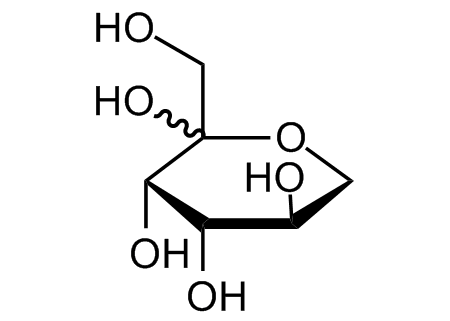D-(-)-Tagatose
| Code | Size | Price |
|---|
| CDX-T0101-G005 | 5 g | £72.00 |
Quantity:
| CDX-T0101-G025 | 25 g | £255.00 |
Quantity:
Prices exclude any Taxes / VAT
Overview
Regulatory Status: RUO
Shipping:
AMBIENT
Storage:
Short Term Storage: +4?C. Long Term Storage: +4?C
Images
Documents
Further Information
Alternate Names/Synonyms:
D-lyxo-2-Hexulose
Appearance:
White to off-white powder or crystals.
CAS:
87-81-0
EClass:
32160000
Form (Short):
solid
Handling Advice:
Protect from light and moisture.
InChi:
InChI=1S/C6H12O6/c7-2-6(11)5(10)4(9)3(8)1-12-6/h3-5,7-11H,1-2H2/t3-,4+,5+,6?/m1/s1
InChiKey:
LKDRXBCSQODPBY-OEXCPVAWSA-N
Long Description:
Chemical. CAS: 87-81-0. Formula: C6H12O6. Molecular Weight: 180.16. D-(-)-Tagatose, is a ketohexose acting as a low-calorie functional sweetener. It is a sugar substitute found in small quantities in nature and produced using a biotransformation method with L-arabinose isomerase as the biocatalyst and D-galactose as the substrate. Tagatose can be used as a preservative in cosmetic, detergent and pharmaceutical formulations. Tagatose is also used in diet soft drinks, chewing gum, frozen yogurt and non-fat ice cream. Potential sugar substitute rarely found in nature. Since it is metabolized differently from sucrose, tagatose has a minimal effect on blood glucose and insulin levels. Tagatose is also approved as a tooth-friendly ingredient for dental products. Tagatose has very similar sweetness to sugar while its glycemic index is very low. Tagatose reduces blood glucose level in the liver by promoting glucokinase activity which promotes transfer of glucose to glycogen. It also inhibits digestive enzymes and degradation of carbohydrates in small intestine which result in inhibition of carbohydrate absorption in the body. Tagatose has shown antioxidant, anti-aging, prebiotic, cytoprotective, antibcaterial and anti-antidiabetic/obesity properties.
MDL:
MFCD00134449
Molecular Formula:
C6H12O6
Molecular Weight:
180.16
Package Type:
Vial
Product Description:
D-(-)-Tagatose, is a ketohexose acting as a low-calorie functional sweetener. It is a sugar substitute found in small quantities in nature and produced using a biotransformation method with L-arabinose isomerase as the biocatalyst and D-galactose as the substrate. Tagatose can be used as a preservative in cosmetic, detergent and pharmaceutical formulations. Tagatose is also used in diet soft drinks, chewing gum, frozen yogurt and non-fat ice cream. Potential sugar substitute rarely found in nature. Since it is metabolized differently from sucrose, tagatose has a minimal effect on blood glucose and insulin levels. Tagatose is also approved as a tooth-friendly ingredient for dental products. Tagatose has very similar sweetness to sugar while its glycemic index is very low. Tagatose reduces blood glucose level in the liver by promoting glucokinase activity which promotes transfer of glucose to glycogen. It also inhibits digestive enzymes and degradation of carbohydrates in small intestine which result in inhibition of carbohydrate absorption in the body. Tagatose has shown antioxidant, anti-aging, prebiotic, cytoprotective, antibcaterial and anti-antidiabetic/obesity properties.
Purity:
98.5% (HPLC)
SMILES:
O[C@@H]1[C@H](O)C(CO)(O)OC[C@H]1O
Solubility Chemicals:
Soluble in water.
Transportation:
Non-hazardous
UNSPSC Category:
Biochemical Reagents
UNSPSC Number:
12352200
Use & Stability:
Stable for at least 2 years after receipt when stored at +4?C.
References
(1) J.C. Paterna, et al.; Toxicol. Appl. Pharmacol. 148, 117 (1998) | (2) B. Buemann, et al.; Metabolism 49, 969 (2000) | (3) Y. Lu & G.V. Levin; Int. J. Cosmet. Sci. 24, 225 (2002) | (4) D.K. Oh; Appl. Microbiol. Biotechnol. 76, 1 (2007) (Review) | (5) Y. Lu, et al.; Diabetes Obes. Metab. 10, 109 (2008) (Review) | (6) K.J. Luecke & L.N. Bell; J. Food Sci. 75, C346 (2010) | (7) T.W. Donner, et al.; Nutr. Res. 30, 801 (2010) | (8) K. Hasibul, et al.; Mol. Med. Rep. 17, 843 (2018) | (9) S. Roy, et al.; J Food Sci. 83, 2699 (2018) (Review)



